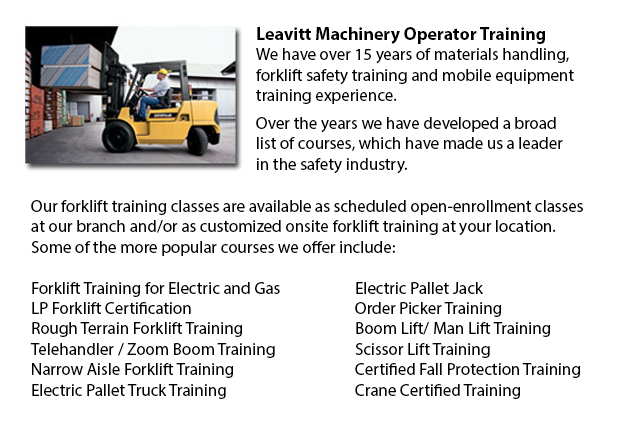
Forklift Training Schools Penticton - Reasons Why Individuals Who Use A Forklift Must Take Whatever Of Our Forklift Training Schools
Are you looking for a job as a forklift driver? Our regulatory-compliant mobile equipment operator training offers instruction in types of forklifts, pre-shift inspection, fuel types and dealing with fuels, and safe utilization of a forklift. Hands-on, practical training helps participants in obtaining basic operational skills. Program content includes current rules governing the use of forklifts. Our proven forklift Schools are designed to offer training on these kinds of trucks: counterbalanced forklift, powered pallet trucks and narrow isle forklift.
When the forklift is in operation, do not raise or lower the forks. Loads must not extend higher than the backrest. This is because of the possibility of the load sliding back in the direction of the operator. Check for overhead obstructions and ensure there is adequate clearance before lifting a load. Stay away from overhead power lines. When the load is raised straight up, tilt it back slightly.
The lift truck is less stable if a load is in a raised position. Make sure that no body ever walks underneath the elevated fork. The operator must not leave the lift truck while the load is raised.
When handling pallets, forks should be level and high enough to go into the pallet and extend all the way under the load. The width of the forks should provide equal weight distribution.
Chock the wheels and set the brakes prior to loading and unloading the truck. The floors must be strong enough to support the weight of both the forklift and its load. Fixed jacks can be installed to be able to support a semi-trailer which is not coupled to a tractor. The height of the entrance door should clear the height of the forklift by a minimum of 5 cm. Edges of rail cars, ramps and docks should be marked and avoid them.
-
Forklift Certification Schools Penticton
Forklift Certification Schools Penticton - In North America, forklift certification is mandatory, making forklift training programs essential for both the business and their employees working as operators of forklifts. Forklift training focuses on sa... More -
Telehandler Training Courses Penticton
Telehandler Training Courses Penticton - The employer has the responsibility to make sure that their personnel are trained to work proficiently utilizing telehandler machinery. The workers have to be assessed for their ability to utilize the machine.... More -
Certified Fall Protection Training in Penticton
There are many injuries at work linked to falling and lots of fall-related deaths reported each and every year. Most of these instances might have been prevented with better training, better precautions in place, and by properly equipping employees b... More -
Zoom Boom Training Penticton
Zoom Boom Training Penticton - Zoom Boom Training is designed to train operators on variable reach forklifts. The objectives of the training are to impart an understanding of the physics of the machine, and to outline the operator's job. This course... More -
Crane Training Schools Penticton
Crane Training Schools Penticton - We have designed various Mobile Crane Operation programs at our Crane Training Schools. These programs are recommended for the experienced operator who needs re-certification or certification, and for inexperienced... More -
Aerial Lift, Boom Lift, Man Lift, Scissor Lift Training in Penticton
Lift tables or also referred to as scissor hoists can lift up both individuals and materials vertically. They are normally utilized in industrial, construction and commercial environments. Normally, the use of a scissor forklift is to lift and lower... More -
Forklift Training Program Penticton
Forklift Training Program Penticton - The forklift is a common powered industrial vehicle which is in wide use nowadays. They are occasionally known as hi los, lift trucks or jitneys. A departments store will utilize the forklift to unload and load m... More -
Overhead Crane Training Penticton
Overhead Crane Training Penticton - An overhead crane is a large crane used to move and lift huge, heavy objects that cannot be lifted by hand. An overhead crane is normally fixed in position while in use. These machines are capable of moving huge vo... More

Forklift Training Penticton
TOLL FREE: 1-888-254-6157
Penticton, British Columbia
forklifttrainingpenticton.com
Email Us
About Us


